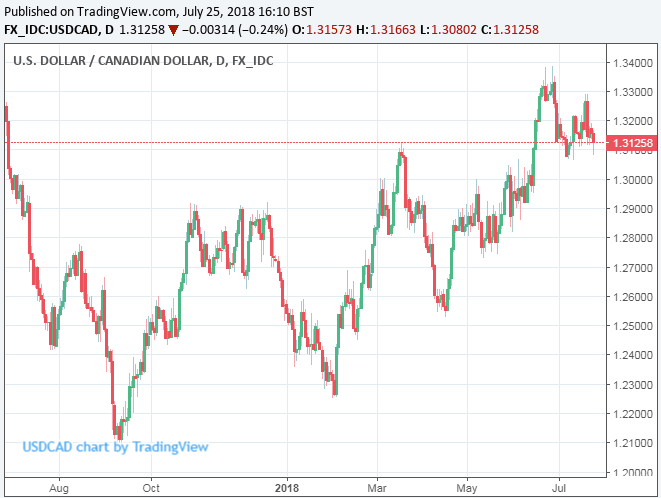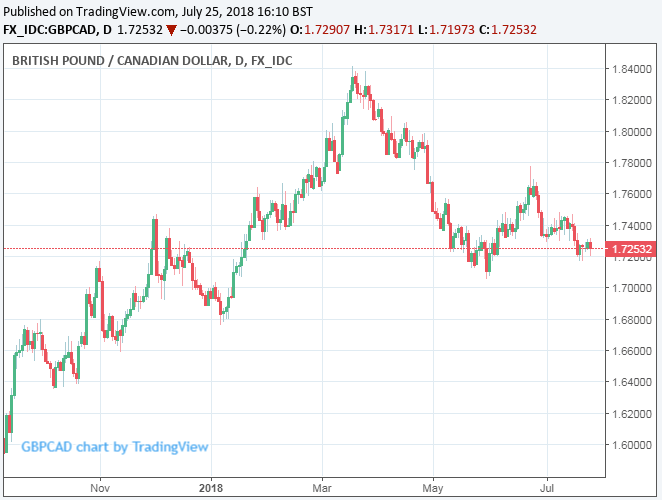Canadian Dollar Forecast to Hit New Lows as Investment Exodus Weighs
- Written by: James Skinner
-
-CAD rises in line with oil prices but fresh losses beckon say analysts.
-NAFTA uncertainty already deterring investment from Canada, data show.
-Without progress, and renewed investment flows, the Loonie will fall.

© COSPV, Adobe Stock
The Canadian Dollar rose broadly Wednesday but fresh losses beckon over the summer months, according to analysts at Bank of America Merrill Lynch, who are arguing that an apparent exodus of investors from the country will drive the Loonie to fresh lows before the summer is out.
Bank of America's call comes hard on the heels of official data showing foreign investors slowing the pace of investment in Canada during May which, coming alongside an increase in Canadian investment elsewhere in the world, left the country with a deficit of net portfolio flows.
This change comes amid increased uncertainty over the outlook for the North American Free Trade Agreement and as rising bond yields south of the border make US government bonds all the more attractive to investors than their Canadian counterparts. In May, the gap between US and Canadian 10 year interest rates widened to 0.73% after US rates reached what was then their highest level since July 2011.
"Net portfolio flows slid back into a moderate -C$3.5bn deficit in May, reversing surpluses recorded over the prior two months, which we believe were a temporary result of optimism related to a presumed NAFTA deal," says Ben Randol, an FX strategist at Bank of America Merrill Lynch. "This is well below the C$7- 8bn per month in net securities flow required to fund Canada’s basic balance deficit, currently -C$93bn over the four quarters through March."
The problem for Canada is that more money leaves the country than comes in each month, in part due to a healthy appetite overseas investment among Canadians, but also due to a range of other factors. The implication of this is that, unless Canada can atttract substantial levels of foreign securities investment each month, more Canadian Dollars will be sold on markets than will be bought and as a result, the Loonie may come under pressure.
"We continue to think that Canada’s ability to attract necessary portfolio investment flow will be compromised by a protracted NAFTA negotiation process and a persistent state of generalized global trade policy uncertainty. Consistent underfunding of Canada’s large external deficit would require an exchange rate adjustment," Randol writes, in a recent briefing for clients. "We recently adjusted our USDCAD forecast higher reflecting these risks and are expecting a rise to 1.37 in 3Q."

Above: USD/CAD rate shown at daily intervals.
The USD/CAD rate was quoted 0.44% lower at 1.3094 Wednesday but is up by 4.14% in 2018 while the Pound-to-Canadian-Dollar rate was 0.51% lower at 1.7205 but has risen 1.6% this year.
Both performances represent heavy losses for the Canadian Dollar, particularly after taking into account that it was up by a similar measure against the greenback and Sterling until around the end of the first-quarter.

Above: Pound-to-Canadian-Dollar rate shown at daily intervals.
"Although crude oil rallied for the fourth day out of the last five, USD/CAD has been unable to register a daily close below uptrend support at 1.3130. This level remains the pivot for our bullish technical view, with additional support located below here at 1.3065. Resistance is located at 1.3191 and 1.3290," says Adam Cole, chief currency strategist at Toronto-headquartered RBC Capital Markets.
NAFTA Threat in Focus
Officials from all sides of the US-Canada-Mexico borders have been attempting, without success, to renegotiate the North American Free Trade Agreement for nearly a year now.
The talks were organised after President Donald Trump criticised the NAFTA pact, which facilitates tariff-free trade between its signatories, and threatened to withdraw the US from it unless more terms more palatable to the administration can be agreed.
President Trump told reporters Monday that he is hopeful a deal can be reached, saying; "I think we’re going to have something worked out. The new president, terrific person."
Incoming Mexican foreign minister Marcelo Ebrard also said Tuesday an agreement could be possible "relatively soon", while Mexico's NAFTA negotiator Jesus Seade has also made encouraging sounds in recent days.
"While the greenback is now overvalued versus several major currencies, CAD isn’t one of them; witness Canada’s generally balanced position on overall trade with the US, and its persistent trade and current account deficit overall. While the C$ has been generally range-bound of late, that hides some weakness relative to oil, as the loonie would typically have flown higher in the wake of WTI reaching the $70/bbl range," says Avery Shenfeld, chief economist at Toronto-based CIBC Capital Markets.
Analysts have previously estimated a US withdrawal from NAFTA could see the Canadian Dollar fall by 20%. The BoC also frequently flags the trade saga as a significant risk to investment and economic growth. As observed by Bank of America, uncertainty over the agreement's fate may already be prompting investors to shun Canadian assets.
"We see dollar-Canada moving sideways in a 1.28 to 1.35 range through 2019, despite the overall weakening trend for the USD. The weakest Canadian dollar levels should come as the threat (but not the actual imposition) of auto tariff heats up, and a return to 1.28 on signs of progress on NAFTA talks next year," Shenfeld adds.
The White House is also pursuing restrictive legislation to govern Chinese investments into the United States and recently ordered a range of tariffs be levied against imports of more than $250 billion in imports of Chinese goods. Trump has also placed tariffs on imports of steel and aluminium from China, Canada, Mexico and the European Union in an effort to reduce the US trade deficit.
The EU has since responded with its own levies on US motorcycles, jeans and whiskey, drawing threats of even more tariffs from the White House, this time targeting the mighty European automotive sector. Fears are that a tit-for-tat tariff fight between the world's largest economies will quickly descend into an all out "trade war" and that this will dent economic growth in all countries it touches.
Advertisement
Get up to 5% more foreign exchange by using a specialist provider to get closer to the real market rate and avoid the gaping spreads charged by your bank when providing currency. Learn more here










